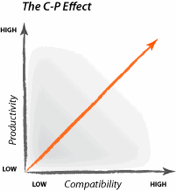
The C-P Effect
How it all began
In 1952 Will Schutz, Ph.D. was recalled into the United States Navy and given the task of learning how people work most productively together and function cooperatively at the highest level of efficiency. His research led to the creation of FIRO theory and FIRO-B® (now Element B), a psychometric instrument that predicts the behavior of people on teams.
Before the Research
Each team member was chosen for technical competence
50% of the teams were judged “productive”
After the Research
Each team member was chosen for technical competence
Behaviorally compatible teams were assembled using scores from the instrument
75% of the teams were judged “productive”
The CP Effect

This illustrates his finding, The C-P Effect. Compatibility — the ability to work well together — is directly related to productivity. The more people on a team have similar preferences for the way they act with one another, the more effective the team becomes. In addition, under pressure, compatible teams perform better than they do without pressure, while incompatible teams become less effective.
Schutz, however, was not satisfied.
Why, he wondered, was it only 75%? What explained the other 25%?
Two decades of exploration
To answer this question, he spent nearly two decades exploring emotions, the functioning of the body, the mind, and the use of experiential methods to understand and change behavior. He finally concluded that the reason teams still got stuck, even when they are compatible, is not because people are different, but rather because one or more people become rigid in their behavior.
Helping people work well together
In 1980, he began to create an integrated series of modules based on FIRO theory that were designed to address the human issues in organizations. His intent was to combine his scientific work—FIRO theory and the instruments—with the experiential material he had learned into a practical, effective approach for helping people work well together.
Elements of Awareness | The Human Element is born
By this time, his assessment had become one of the most widely used instruments in training and had developed a devoted following. He was pleased but slightly dismayed that his research tool was being used for training purposes. Since he too wanted to use the instrument for training, he revised the instrument, creating the next generation of it, called Element B. At the same time he expanded and improved FIRO theory and created additional FIRO-based instruments based on the revised theory. These instruments, called the Elements of Awareness, were specifically designed to be used in training and were incorporated into the new modules. These modules became The Human Element.
